12.3 Social Cognition: Understanding People
Because other people are the source of most of our rewards and punishments, it isn’t surprising that we spend a lot of our time trying to understand them. Social cognition is the processes by which people come to understand others. We are constantly making inferences about what other people think, feel, and want (“Ethan is angry because he thinks Abby really likes Jacob”), and about what kinds of people they are deep down inside (“Ethan is such a possessive person”). We base these inferences on two kinds of information: the social categories to which people belong, and the specific things that people say and do.
social cognition
The processes by which people come to understand others.
Stereotyping: Drawing Inferences from Categories

You’ll recall from the Language and Thought chapter that categorization is the process by which people identify a stimulus as a member of a class of related stimuli. Once we have identified a novel stimulus as a member of a category (“That’s a textbook”), we can then use our knowledge of the category to make educated guesses about the properties of the novel stimulus (“It’s probably expensive”) and act accordingly (“I think I’ll download it illegally”).
What we do with textbooks we also do with people. No, not the illegal downloading part. The educated guessing part. Stereotyping is the process by which people draw inferences about people based on their knowledge of the categories to which those people belong. The moment we categorize a person as an adult, a male, a baseball player, and a Russian, we can use our knowledge of those categories to make some educated guesses about him—
stereotyping
The process by which people draw inferences about people based on their knowledge of the categories to which those people belong.
403
Hot Science: The Wedding Planner
The Wedding Planner
The human brain has nearly tripled in size in just 2 million years. The social brain hypothesis (Shultz & Dunbar, 2010) suggests that this happened primarily so that people could manage the everyday complexities of living in large social groups. What are those complexities?
Well, just think of what you’d need to know in order to seat people at a wedding. Does Uncle Jacob like Grandma Nora, does Grandma Nora hate Cousin Caleb, and if so, does Uncle Jacob hate Cousin Caleb too? With a guest list of just 150 people, there are more than 10,000 of these dyadic relationships to consider—
In a 2010 study, Mason et al. directly compared people’s abilities to solve social and nonsocial problems. The nonsocial problem involved drawing inferences about metals. Participants were told that there were two basic groups of metals and that metals in the same group “attracted” each other, whereas metals in different groups “repelled” each other. Then, participants were told about the relationships between particular metals and were asked to draw inferences about the missing relationship. For example, participants were told that gold and tin were both repelled by platinum, and they were then asked to infer the relationship between gold and tin. (The correct answer is “They are attracted to each other.”)

The experimenters also gave participants a social version of this problem. Participants were told about two groups of people. People who were in the same group were said to be attracted to each other, whereas people who were in different groups were said to be repelled by each other. Then participants learned about the relationships between particular people—
Although the social and nonsocial tasks were logically identical, results showed that participants were considerably faster and more accurate when drawing inferences about people than about metals. When the researchers replicated the study inside an MRI machine, they discovered that both tasks activated brain areas known to play a role in deductive reasoning but that only the social task activated brain regions known to play a role in understanding other minds.
It appears that our ability to think about people outshines our ability to think about most everything else, which is good news for the social brain hypothesis—
How are stereotypes useful?
1. Stereotypes Can Be Inaccurate
We draw inferences about individuals based on their groups, but some of the things we believe about those groups simply aren’t true. For instance, there is no evidence to indicate that Jews are especially greedy or that African Americans are especially lazy. Nonetheless, many American college students hold those beliefs, and have done so for most of the last century (Gilbert, 1951; Karlins, Coffman, & Walters, 1969; Katz & Braly, 1933). We aren’t born with beliefs like these, so how do we acquire them? We pay attention to what people say—
404
2. Stereotypes Can Be Overused
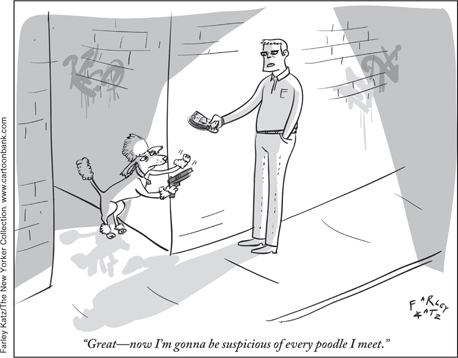
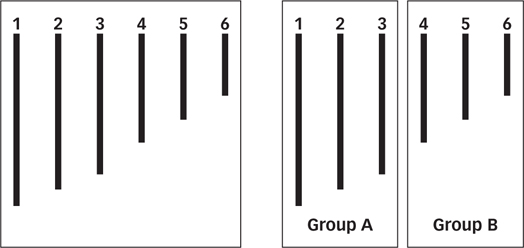
How does categorization warp perception?
Because all thumbtacks are pretty much alike, our stereotypes about thumbtacks (small, cheap, painful when chewed) are quite useful. We will rarely be mistaken if we generalize from one thumbtack to another. But human categories are so variable that our stereotypes may offer only vague clues about the individuals who populate those categories. You probably believe that men have greater upper body strength than women do, and that belief is correct—
Alas, we don’t always recognize this because the mere act of categorizing a stimulus tends to warp our perceptions of that category’s variability. For instance, participants in some studies were shown a series of lines of different lengths (see FIGURE 12.12; McGarty & Turner, 1992; Tajfel & Wilkes, 1963). For one group of participants, the longest lines were labeled Group A, and the shortest lines were labeled Group B, as they are on the right side of FIGURE 12.12. For the second group of participants, the lines were shown without these category labels, as they are on the left side of FIGURE 12.12. When later asked to draw the lines from memory, those participants who had seen the category labels overestimated the similarity of the lines that shared a label and underestimated the similarity of lines that did not. What’s true of lines is true of people as well. The mere act of categorizing people as Blacks or Whites, Jews or Gentiles, artists or accountants can cause us to underestimate the variability within those categories (“All artists are flaky”) and to overestimate the variability between them (“Artists are much flakier than accountants”). When we underestimate the variability within a human category, we overestimate how useful our stereotypes about it will be (Park & Hastie, 1987; Rubin & Badea, 2012).
3. Stereotypes Can Be Self-Perpetuating
When we meet a truck driver who likes ballet more than football or a senior citizen who likes Eminem more than Bach, why don’t we simply abandon our stereotypes of these groups? The answer is that stereotypes perpetuate themselves, and they do this in two ways.
First, stereotypes can bias our perceptions, leading us to believe that those stereotypes have been confirmed when actually they have not (Fiske, 1998). In one study, participants listened to a radio broadcast of a college basketball game and were asked to evaluate the performance of one of the players. Although all participants heard the same prerecorded game, some were led to believe that the player was African American, and others were led to believe that the player was White. Participants’ stereotypes led them to expect different performances from Black and White athletes—
perceptual confirmation
The tendency for people to see what they expect to see.
How do stereotypes perpetuate themselves?
405
Second, our stereotypes can cause other people to behave in ways that actually do confirm the stereotypes we hold about them. In one study (Steele & Aronson, 1995), African American and White students took a test, and half the students in each group were asked to list their race at the top of the exam. When students were not asked to list their races, they performed at their academic level, but when students were asked to list their races, African American students became anxious about confirming a negative stereotype of their group, and this anxiety led them to perform below their academic level (see FIGURE 12.13). Self-fulfilling prophecy is the tendency for people to behave as they are expected to behave, and it is one of the ways in which stereotypes perpetuate themselves. What’s so troubling about this is that anyone who expected African-
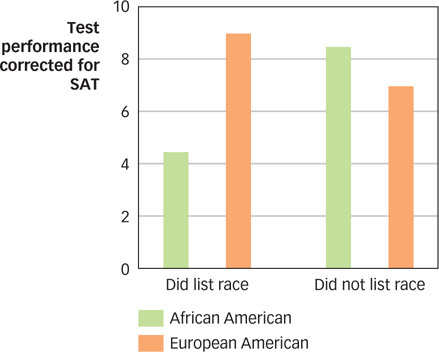
self-fulfilling prophecy
The tendency for people to behave as they are expected to behave.
4. Stereotyping Can Be Unconscious and Automatic
If we recognize that stereotypes are inaccurate, overused, and self-
For example, in one study, participants played a video game in which photos of Black or White men holding either guns or cameras were briefly flashed on the screen. Participants earned money by shooting men with guns and lost money by shooting men with cameras. All participants made mistakes, but they tended to make two in particular, namely, they mistakenly shot Black men holding cameras and mistakenly failed to shoot White men holding guns (Correll et al., 2002). Although the photos appeared on the screen so quickly that participants did not have enough time to consciously consider their stereotypes, those stereotypes worked unconsciously, causing them to mistake a camera for a gun when it was in the hands of a Black man and a gun for a camera when it was in the hands of a White man. What’s more, Black participants were just as likely to make this pattern of errors as were White participants!
Can we decide not to stereotype?
Stereotyping is often unconscious and automatic, but that doesn’t mean it is inevitable (Blair, 2002; Kawakami et al., 2000; Milne & Grafman, 2001; Rudman, Ashmore, & Gary, 2001). For instance, in one study, police officers received special training before playing the gun-
Attribution: Drawing Inferences from Actions
In 1963, Dr. Martin Luther King Jr. gave a speech in which he described his vision for America: “I have a dream that my four children will one day live in a nation where they will not be judged by the color of their skin but by the content of their character.” Research on stereotyping demonstrates that Dr. King’s concerns are still justified. We do indeed judge others by the color of their skin—

406
Probably not. Treating a person as an individual means judging that person by his or her own words and deeds, and this turns out to be a lot more difficult than it sounds because the relationship between what a person is and what a person says or does is neither simple nor straightforward. An honest person may lie to save a friend from embarrassment, and a dishonest person may tell the truth to bolster her credibility. Happy people have weepy moments, polite people can be rude in traffic, and those who despise us can be flattering when they need a favor. In short, people’s behavior sometimes tells us about the kinds of people they are—
An attribution is an inference about the cause of a person’s behavior (Epley & Waytz, 2010; Gilbert, 1998). We make situational attributions when we decide that a person’s behavior was caused by some temporary aspect of the situation in which it occurred (“Sarah’s crying because she just got some bad news”), and we make dispositional attributions when we decide that a person’s behavior was caused by a relatively enduring tendency to think, feel, or act in a particular way (“Sarah’s crying because she’s just such a baby”). Research shows that this decision is quite difficult and that people often make the wrong one. Specifically, people are prone to correspondence bias which is the tendency to make dispositional attributions instead of situational attributions (Gilbert & Malone, 1995; Jones & Harris, 1967; Ross, 1977).
attribution
An inference about the cause of a person’s behavior.
correspondence bias
The tendency to make dispositional attributions instead of situational attributions.
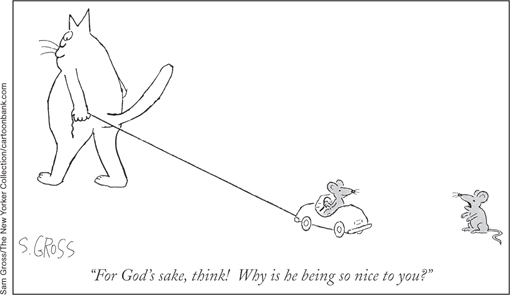
Why do we tend to make dispositional attributions?
For example, volunteers in one experiment played a trivia game in which one participant acted as the quizmaster and made up a list of unusual questions, another participant acted as the contestant and tried to answer those questions, and a third participant acted as the observer and simply watched the game. The quizmasters tended to ask tricky questions based on their own idiosyncratic knowledge, and contestants were generally unable to answer them. After watching the game, the observers were asked to decide how knowledgeable the quizmaster and the contestant were. Although the quizmasters had asked good questions and the contestants had given bad answers, it should have been clear to the observers that all this asking and answering was a product of the roles each person had been assigned to play and that the contestant would have asked equally good questions and the quizmaster would have given equally bad answers had their roles been reversed. And yet observers tended to rate the quizmaster as more knowledgeable than the contestant (Ross, Amabile, & Steinmetz, 1977) and were more likely to choose the quizmaster as their own partner in an upcoming game (Quattrone, 1982). Even when we know that a successful athlete had a home field advantage or that a successful entrepreneur had family connections, we tend to attribute the individual’s success to talent and tenacity. Research shows that this happens because information about situations is often hard to get and hard to use (Gilbert, Pelham, & Krull, 1988). As a result, we tend to believe that other peoples’ actions are caused by their dispositions even when there is a perfectly reasonable situational explanation.
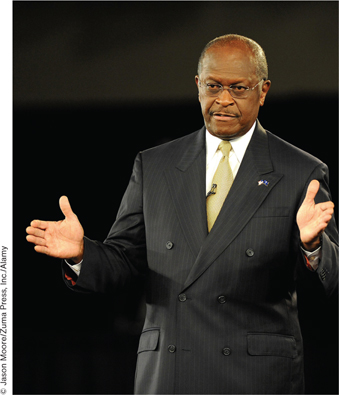
The correspondence bias is stronger under some circumstances than others. For example, we seem to be more prone to correspondence bias when judging other people’s behavior than when judging our own. The actor-observer effect is the tendency to make situational attributions for our own behaviors while making dispositional attributions for the identical behavior of others (Jones & Nisbett, 1972). When college students are asked to explain why they and their friends chose their majors, they tend to explain their own choices in terms of situations (“I chose economics because my parents told me I have to support myself as soon as I’m done with college”) and their friends’ choices in terms of dispositions (“Leah chose economics because she’s materialistic”) (Nisbett et al., 1973). The actor–
actor–observer effect
The tendency to make situational attributions for our own behaviors while making dispositional attributions for the identical behavior of others.
407

Ap photo/Doug Mills
SUMMARY QUIZ [12.3]
Question 12.9
| 1. | What is the process by which people come to understand others? |
- dispositional attribution
- the accuracy motive
- social cognition
- cognitive dissonance
c.
Question 12.10
| 2. | A common occupational stereotype is that lawyers are manipulative. Most people who subscribe to this stereotype |
- believe that the stereotype applies to all lawyers.
- believe that the stereotype accurately applies to just a small percentage of lawyers.
- believe that lawyers are more likely than others to have this characteristic.
- would not be likely to misperceive lawyers when they actually meet.
c.
Question 12.11
| 3. | The tendency to make a dispositional attribution even when another person’s behavior was caused by the situation is referred to as |
- the actor-
observer effect. - stereotyping.
- perceptual confirmation.
- correspondence bias.
d.
408